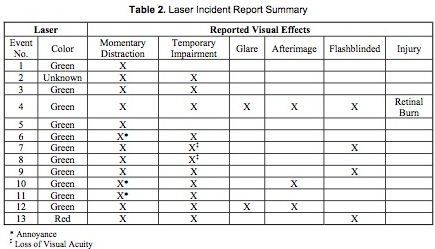Home
A comprehensive resource for safe and responsible laser use

2006 FAA incident review
An October 2006 U.S. Federal Aviation Administration study looked at 90 laser/aircraft incidents from January 1 2004 to January 31 2005. Of these, 44 occurred in calendar year 2004 and 46 occurred during January 2005.
Results
Fifty-three of the 90 reports involved laser exposure of commercial aircraft. Lasers illuminated the cockpit in 41 (46%) of the 90 incidents. Of those, 13 (32%) incidents resulted in visual impairment or distraction to a pilot, including one incident that reportedly resulted in ocular injury. These are shown in the table reprinted below.

Description of Incident #4 (retinal edema or swelling)
On September 22, 2004 at 9:30 PM MST, a Delta Airlines B-737 aircraft (DAL 1025) was on final approach to Runway 35 at Salt Lake City (UT) International Airport at approximately 1,300 above ground level (AGL; 5,500 ft MSL), when a green laser light hit the Flight Deck.
The First Officer (FO) was flying the aircraft at the time of the incident. Both Captain and FO saw the bright green light coming from the ground at the one to two o’clock position for a period of about 5 seconds. The Captain recognized the light as a laser and turned his eyes away while the FO did not. The FO landed the aircraft safely, but reported some loss of depth perception, causing him to flare too high.
After the flight, the FO noticed blurring in his eyes. The next day his vision was more blurred. An ophthalmologist’s examination found retinal edema. The FO was unable to fly for about 3 weeks and remained sensitive to bright lights for some time.
[Note: A retinal edema is a swelling and thickening of the retina. It does not appear to be the same as a retinal “burn” as listed in Table 2 shown above. One expert who has examined pilots and has studied this incident told LaserPointerSafety.com that “there are questions” about the injury and that this did not cause “true, cellular tissue damage.” As of October 2011, this appears to be the only FAA-reported incident where a pilot had a potentially serious or permanent eye injury.]
Topics
The study also discusses the reasons for the increase in incidents, makes recommendations for reducing the problem, discusses countermeasures such as laser eye protection and laser event recorders, and describes potential terrorist use of lasers:
- “Fortunately, these incidents appear to be the careless acts of thoughtless individuals, rather than purposeful acts of terrorism.”
Conclusion
The study of laser illumination incidents in the national airspace system can identify the operational problems that result from such events. Improved reporting and analysis of laser events enhances aviation safety by providing the FAA with data necessary to assist in the development of methods for mitigating the effects of laser exposure.
Links
- The FAA study: “A Review of Recent Laser Illumination Events in the Aviation Environment”, DOT/FAA/AM-06/23, US DOT FAA Office of Aerospace Medicine, October 2006. Study produced by Van Nakagawara, Kathryn J. Wood, and Ron W. Montgomery.
- “Laser Illumination of Pilots in the National Airspace System” PowerPoint presentation by Van Nakagawara (lead author of the above study), addressing the plenary session of the International Laser Safety Conference, March 2009 in Reno, NV. Gives an overview of the issue of laser/aviation safety. Contains statistics on laser incidents by year, region, time of day, etc.